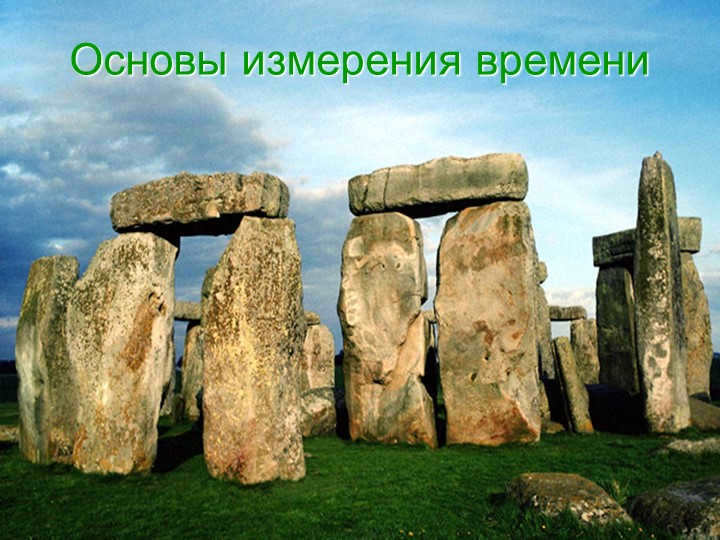
Currently, there are additional cumulative discounts (ranging from 2% to 25%) available for 58,747 educational institutions. In order to determine the specific discount applicable to all staff members of your educational institution, please log into your personal Infoworks account.


Advanced training program
Principles, techniques, and application of teaching elementary school students the fundamentals of chess within the framework of implementing FSES LEO.
In addition to this promotion, you can take advantage of the discount offered by your educational institution (which is based on the number of colleagues who have already enrolled in Infowork courses).
Currently, 58,747 educational institutions are benefiting from additional cumulative discounts (ranging from 2% to 25%). To determine the applicable discount for all employees of your educational institution, please log in to your personal Infoworks account.


Advanced training program
Techniques and strategies for promoting Russian national identity in accordance with the Federal State Educational Standard
In addition to this promotion, we can also offer a discount for your educational institution based on the number of colleagues who have completed Infowork courses.
Currently, 58,747 educational institutions are eligible for various discounts ranging from 2% to 25%. To find out the discount that applies to all employees of your educational institution, please log in to your personal Infoworks account.


Utilizing Kinesiology Techniques in Interacting with Children with Attention Deficit Disorder
Breakdown of the Slideshow Content:

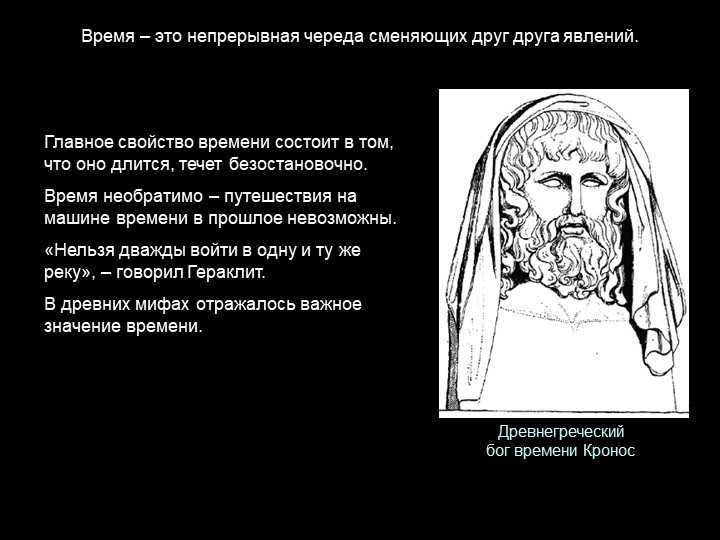
Slide 2: The Ancient Greek deity Kronos, the god of time
Time, the primary characteristic of which is its continuous and relentless flow, is an irreversible force. It is impossible to journey back in time using a time machine, as Heraclitus once said, “You cannot step into the same river twice.” The significance of time is evident in ancient myths.
Time represents an unbroken sequence of evolving events.
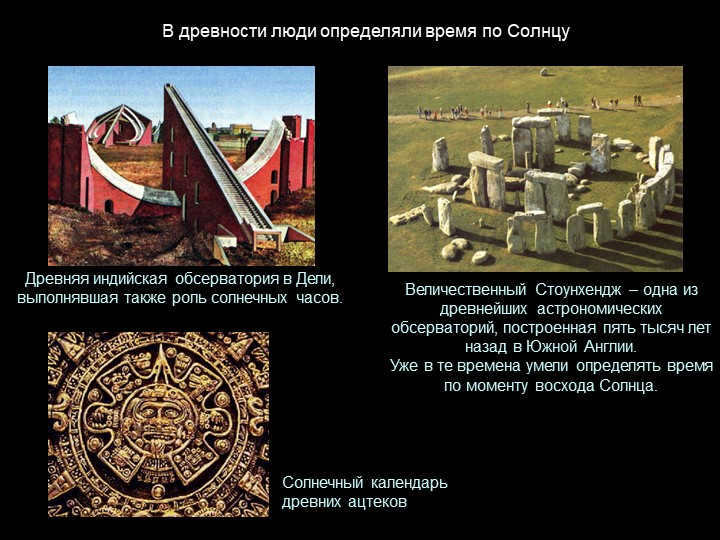
During ancient times, individuals used the position of the Sun to calculate time. One example of this is an ancient Indian observatory located in Delhi, which also functioned as a sundial. Another well-known ancient astronomical observatory is Stonehenge, which was constructed around five thousand years ago in Southern England. Even during that era, people understood how to determine the time based on the moment of sunrise. Additionally, the ancient Aztecs had their own solar calendar.
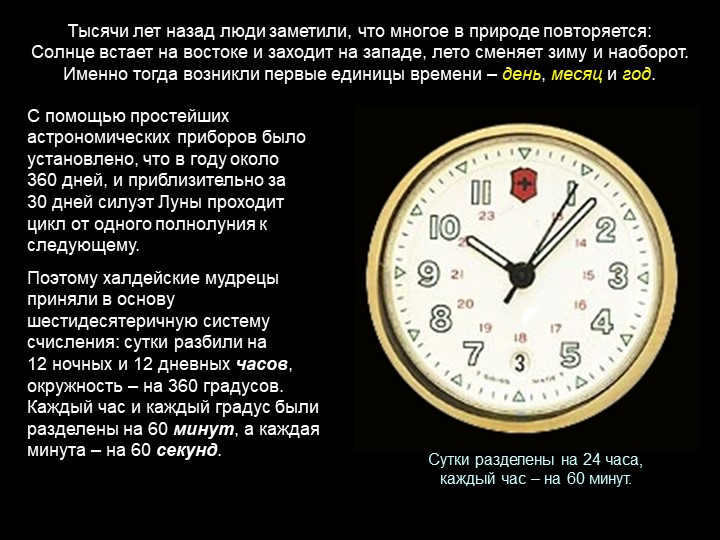
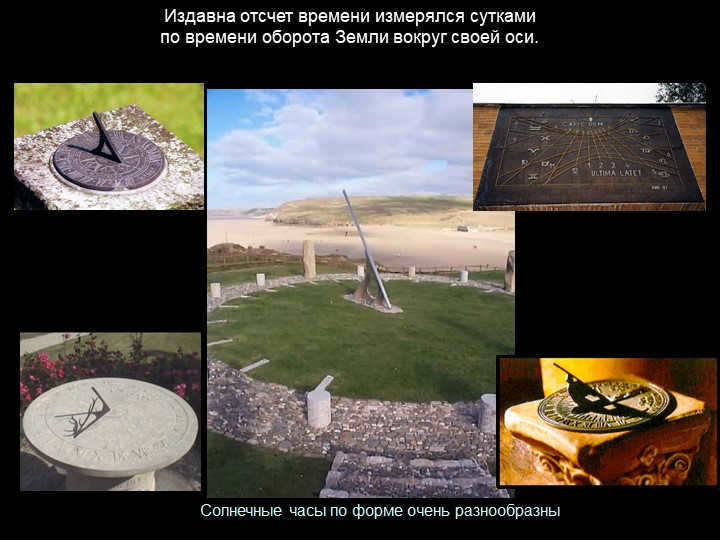
Slide 5 Sundials come in a wide range of shapes and sizes
Throughout history, days have been measured by the rotation of the Earth on its axis.
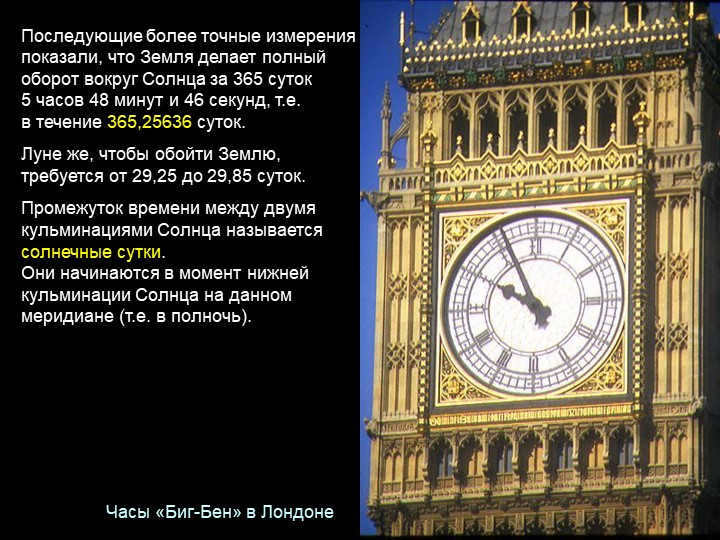

6 slide More accurate subsequent measurements revealed that the Earth completes a full revolution around the Sun in 365 days, 5 hours, 48 minutes, and 46 seconds, or 365.25636 days.
On the other hand, the Moon takes between 29.25 and 29.85 days to orbit the Earth.
The time period between the two
high points of the Sun is known as
a solar day.
These days begin at the moment when the Sun reaches its highest point in a given meridian (i.e., at midnight).
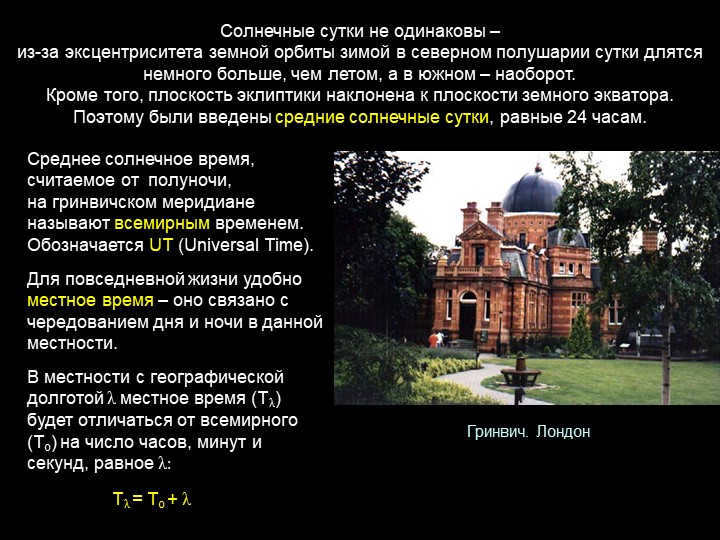
Slide 7 The length of the solar day varies due to the Earth’s orbit being eccentric. In the northern hemisphere, the day is slightly longer in winter compared to summer, while in the southern hemisphere, it is the opposite. Additionally, the ecliptic plane is inclined to the Earth’s equator. To account for these variations, the concept of an average solar day of 24 hours was introduced. This system is based on the mean solar time reckoned from midnight on the Greenwich meridian in London, known as Universal Time (UT).
Local time, on the other hand, is more relevant to everyday life as it is tied to the natural cycle of day and night in a specific area.
In a location with a geographic longitude of λ, the local time (Tλ) will differ from Universal Time (To) by an amount corresponding to λ in hours, minutes, and seconds.
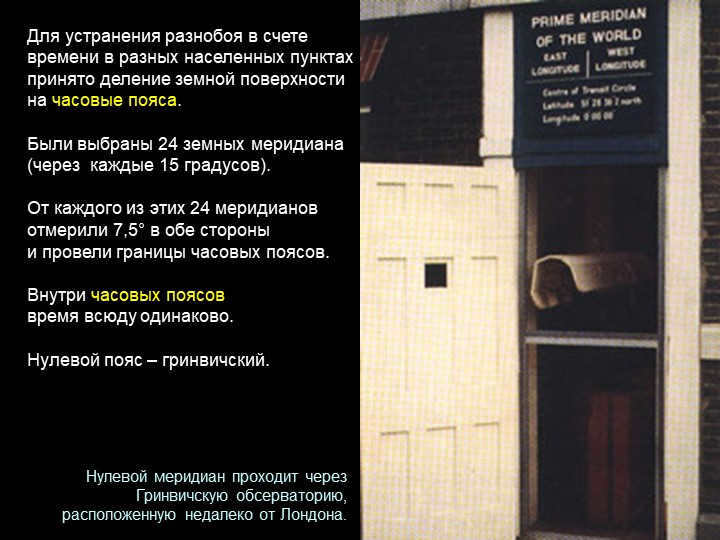

Slide 8: To resolve the variation in time measurement across different locations, the Earth’s surface is divided into time zones.
Twenty-four meridians on Earth were selected (every 15 degrees).
From each of these 24 meridians, 7.5° in either direction, time zone boundaries were established.
Within each time zone, time remains consistent throughout.
The zero time zone is the Greenwich time zone. The prime meridian runs through the Greenwich Observatory near London.
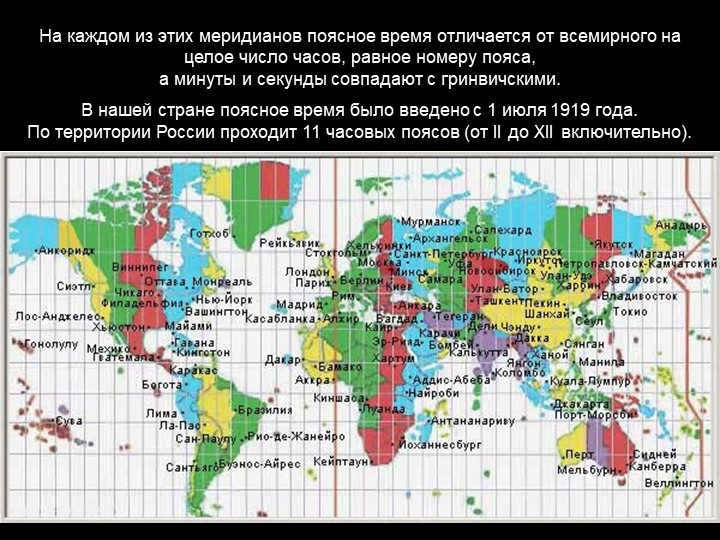

On every meridian, the time zone differs from universal time by a whole number of hours that corresponds to the zone number.
Minutes and seconds remain the same as Greenwich time.
In our country, zone time was implemented on July 1, 1919.
Russia has 11 time zones (from II to XII inclusive).
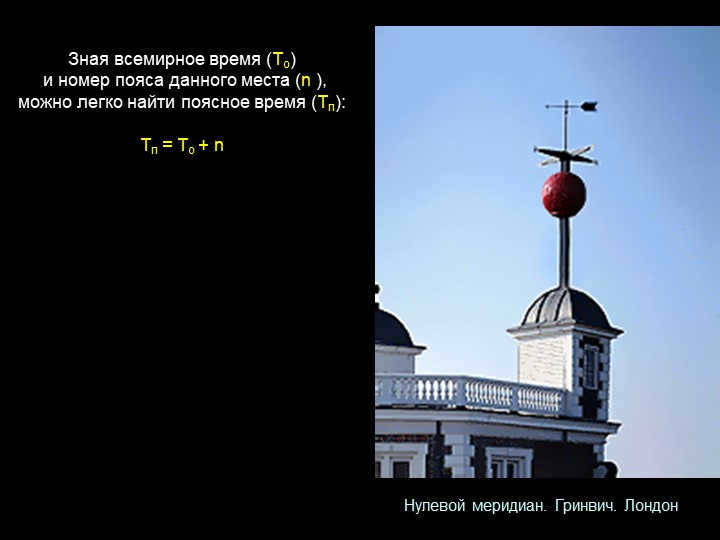

Slide 10: Understanding world time (To)
and the zone number of a specific location (n), allows for the easy determination of the time zone (Tp):
Zero meridian. Greenwich. London
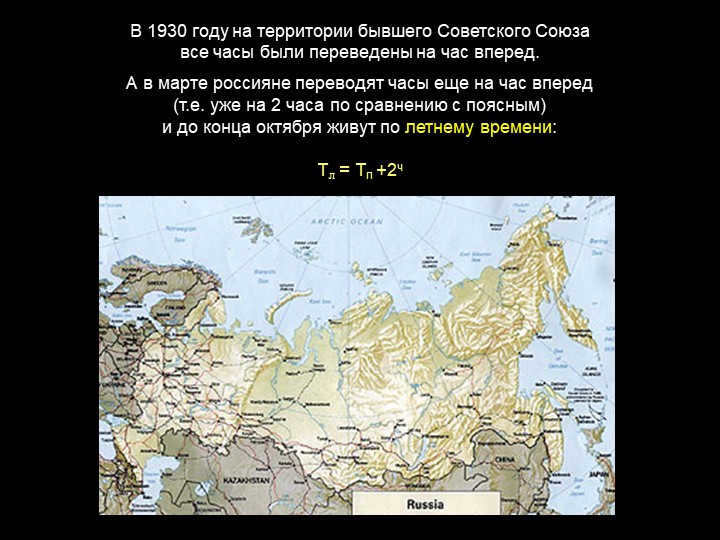
During the year 1930, in the previous Soviet Union, a decision was made to adjust all clocks in the region. This adjustment involved moving all clocks forward by one hour. Additionally, in the month of March, the Russians decided to further advance their clocks by an additional hour, resulting in a total advance of two hours ahead of the standard time zone. This adjustment was implemented to make better use of daylight and was observed until the end of October.
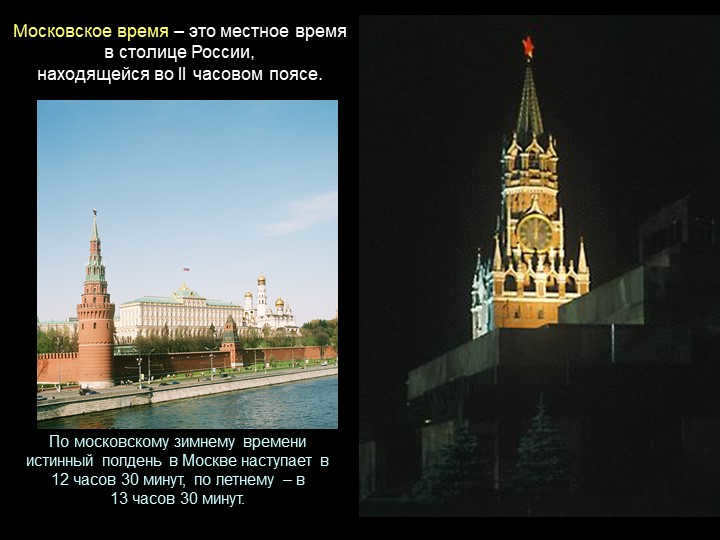
12 slide Moscow time is the current time in the capital of Russia, which is situated in the second time zone.
As per Moscow standard time, the exact midday in Moscow is observed at 12:30 p.m., and as per Moscow daylight time – at 13:30 p.m.
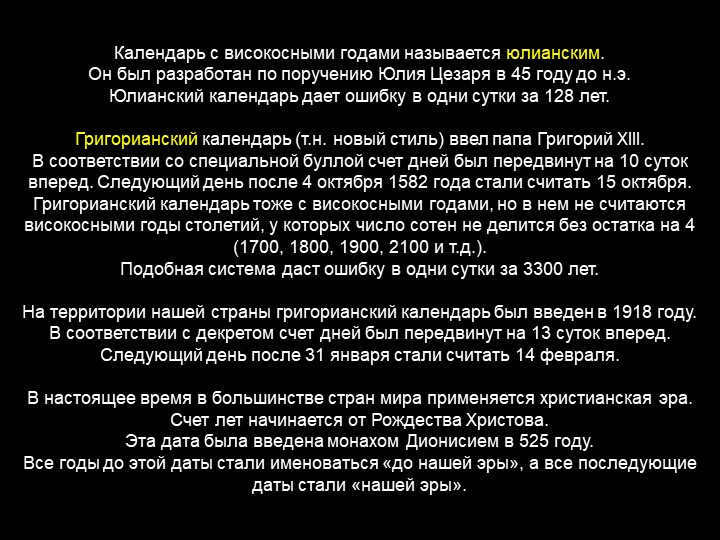

Slide 13: The Julian calendar is the calendar that includes leap years. It was created by Julius Caesar in 45 BC. The Julian calendar has a one-day error every 128 years.
The Gregorian calendar, also known as the new style calendar, was introduced by Pope Gregory XIII. According to a special decree, the calendar was adjusted by moving the count of days forward by 10 days. The day after October 4, 1582 became October 15. The Gregorian calendar also includes leap years, but it excludes leap years for centuries that are not divisible by 4 without a remainder (e.g. 1700, 1800, 1900, 2100, etc.). This system will have a one-day error every 3300 years.
In 1918, the Gregorian calendar was implemented in our country, resulting in a shift of 13 days forward in the counting of days. This means that February 14 became the next day after January 31.
Currently, the majority of countries around the world use the Christian era, which starts counting years from the Nativity of Christ. The monk Dionysius introduced this date in 525. Years prior to this date are referred to as “B.C.” and all dates after are considered part of “our era”.
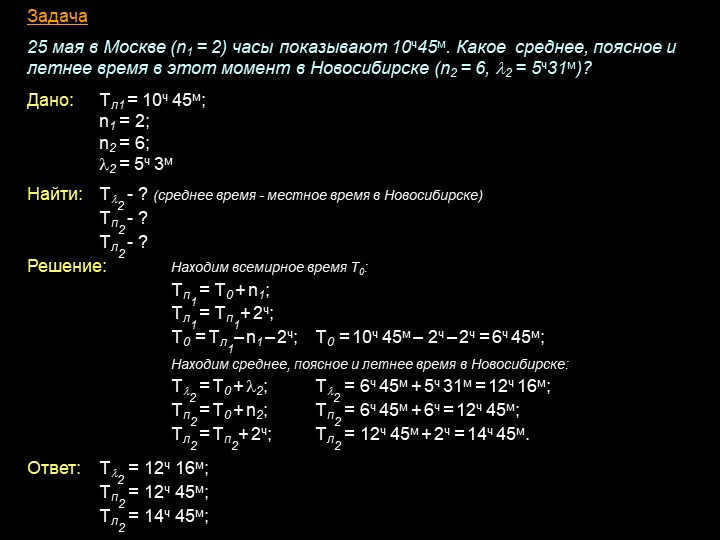
On May 25th in Moscow (n1 = 2), the clock indicates 10h45m. What is the average time, time zone, and daylight saving time at this moment in Novosibirsk (n2 = 6, λ2 = 5h31m)?
Given: Tl1 = 10h45m;
n1 = 2;
n2 = 6;
λ2 = 5h 3m
Find: Tλ2 – ? (average time – local time in Novosibirsk)
Tp2 – ?
Tl2 – ?
Solution: Find the world time T0:
Tp1 = T0 + n1;
Tl1 = Tp1 + 2h;
T0 = Tl1- n1 – 2h; T0 = 10h 45m – 2h – 2h = 6h 45m;
Let’s determine the average time, time zone, and daylight saving time in Novosibirsk:
Tλ2 = T0 + λ2; Tλ2 = 6h 45m + 5h 31m = 12h 16m;
Tp2 = T0 + n2; Tp2 = 6h 45m + 6h = 12h 45m;
Tl2 = Tp2 + 2h; Tl2 = 12h 45m + 2h = 14h 45m.
Brief summary of the document:
The document aims to provide didactic instruction on the measurement of time, helping individuals establish connections between new knowledge and previously acquired information while expanding their horizons. It also serves as a developing tool, allowing for the improvement and deepening of knowledge, as well as the formation of cognitive needs and interests with positive motivation. Additionally, it has educational value, fostering the ability to create and comprehend knowledge effectively. The document offers evidence for a portfolio, eternal access for only 99 rubles, and over 3,800 video lectures available to everyone.
World Time ( UT ) is a time standard that relies on the Earth’s rotation. There are multiple variations of world time, each differing only by a few seconds. The most widely used versions are Coordinated Universal Time (UTC) and UT1 (refer to § Versions ). All forms of UT, excluding UTC, are determined by the Earth’s rotation in relation to distant celestial objects, such as stars and quasars. However, they include a scaling factor and other adjustments to align them more closely with solar time. UTC, on the other hand, is based on international atomic time and includes additional seconds to keep it within 0.9 seconds of UT1.
Universal Time and Standard Time
Prior to the implementation of standard time, each city across the globe that utilized clocks would set its own official clock based on the local position of the Sun (refer to Solar Time). This practice continued until the introduction of rail transportation in Great Britain, which enabled rapid travel over long distances, necessitating the frequent adjustment of clocks as trains passed through multiple towns. To address this issue, Greenwich Mean Time (GMT) was established as the mean solar time at the prime meridian in Greenwich, England. Regardless of local solar noon, all clocks in Great Britain were synchronized to GMT. Chronometers or telegraphy were employed to ensure the synchronization of these clocks.
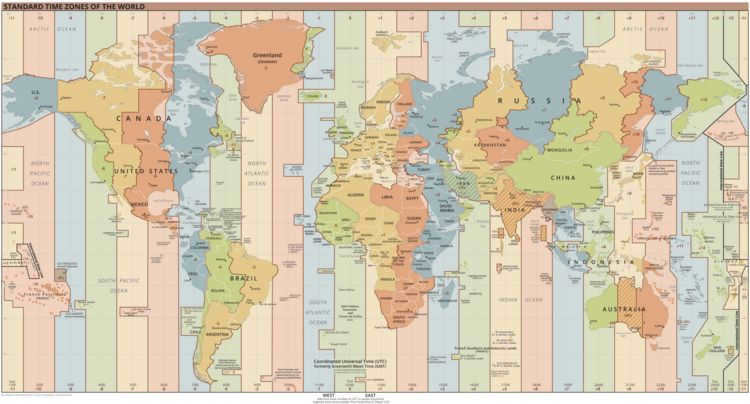
As of 2016, the world is divided into standard time zones. Each zone is assigned a number that represents the number of hours to be added to Coordinated Universal Time (UTC) to obtain the local time.
Standard time was originally proposed by Sir Sandford Fleming, a Scottish-Canadian, during a meeting of the Canadian Institute in Toronto on February 8, 1879. Fleming put forward the idea that standard time zones could be implemented locally, but that they would be subservient to his concept of a single global time, which he referred to as Cosmic Time. Under his proposal, the world would be divided into twenty-four time zones, with each zone covering a 15-degree span of longitude. All clocks within each zone would be set to the same time, but would differ by one hour from clocks in neighboring zones. The Royal Observatory at Greenwich was designated as the recommended reference point for world time on October 22, 1884, at the conclusion of the International Meridian Conference. This particular location was chosen because, by 1884, two-thirds of all nautical charts and maps were already using it as the prime meridian. However, Fleming’s time zone concept was not accepted by the conference, as it fell outside the scope of the conference’s main objective, which was to select a basis for universal time and the prime meridian.
In 1935, the International Astronomical Union suggested the use of the term universal time as a more precise alternative to Greenwich Mean Time (GMT), as GMT could be interpreted in different ways, either as astronomical days beginning at noon or civilian days beginning at midnight. Some countries still commonly use the term Greenwich Mean Time when referring to civil timekeeping.
Measurement
By observing celestial bodies crossing the meridian each day, time can be measured based on the rotation of the Earth. Astronomers have discovered that observing the stars as they cross the meridian is a more accurate method of establishing time than observing the position of the Sun in the sky. The determination of UT relative to international atomic time (TAI) is now done using a technique called very long baseline interferometry (VLBI) of distant quasars. This technique can determine UT1 with an accuracy of 15 microseconds or even better.
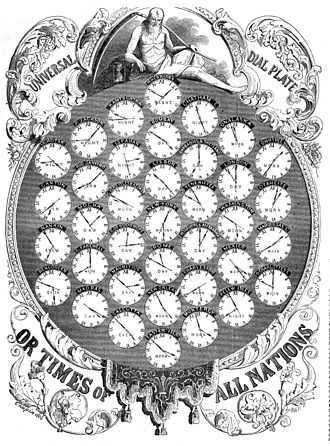
The "Universal Dial Plate" from 1853 illustrates the comparative timing of various nations prior to the establishment of Universal Time.
The International Earth Rotation and Reference Systems Service (IERS) is responsible for overseeing the rotation of the Earth and Universal Time. The International Astronomical Union also plays a role in establishing standards, but the International Telecommunication Union (ITU) serves as the ultimate authority in broadcasting standards.
The rotation of the Earth is somewhat irregular and gradually slows down due to tidal acceleration. Additionally, the length of a second was determined by observing the moon between 1750 and 1890. These factors contribute to the modern average solar day being slightly longer than the traditional 86,400 seconds per day. To account for the Earth’s irregular rotation, astronomers introduced ephemeris time, which has since been replaced by terrestrial time (TT). Since universal time is based on the Earth’s rotation, which is not as accurate as atomic frequency standards, an adjustment called an extra second is necessary for atomic time. As of 2019, broadcasting time remains synchronized with solar time. The civil broadcasting standard for time and frequency usually closely follows International Atomic Time but may occasionally make adjustments to keep it aligned with mean solar time.
Versions
There are multiple variations of universal time:
- UT0 – Universal Time, determined at an observatory by observing the daily movement of stars or extragalactic radio sources, and from range observations of the Moon and artificial satellites. The observatory’s location is assumed to have fixed coordinates in a terrestrial reference frame (such as the International Terrestrial Reference Frame), but the Earth’s axis of rotation moves along the Earth’s surface, which is known as polar motion. UT0 does not include adjustments for pole motion. The difference between UT0 and UT1 is approximately a few tens of milliseconds. The term UT0 is no longer in use.
- UT1 – is the fundamental form of Universal Time. It is calculated based on the positions of distant quasars using long-baseline interferometry, laser location of the Moon and artificial satellites, and GPS satellite orbits, as accurate measurements of the Sun are challenging. UT1 is consistent worldwide and is directly linked to the Earth’s rotation angle relative to distant quasars, specifically the International Celestial Reference Frame (ICRF), with minor adjustments. These observations allow us to determine the Earth’s angle relative to the ICRF, known as the Earth rotation angle (ERA), which replaces Greenwich Mean Stellar Time in modern times. UT1 is essential for monitoring the ratio of time.
- UT1R – is an adjusted version of UT1 that eliminates cyclic fluctuations resulting from tidal effects. It incorporates 62 filtering intervals spanning from 5.6 days to 18.6 years.
- UT2 – is a modified rendition of UT1 designed to remove periodic seasonal fluctuations. It is primarily of historical significance and is infrequently employed in contemporary times. It is defined by.
- UTC (Coordinated Universal Time) is a precise time measurement that closely matches UT1. It serves as the global standard for civil time. UTC is based on counting SI seconds in sync with TAI. Usually, there are 86400 SI seconds in a day, but to keep UTC within 0.9 seconds of UT1, occasional random extra seconds are added. As of 2016, these extra seconds have always been positive (making days with an extra second 86,401 seconds long). If a level of accuracy better than one second is not necessary, UTC can be used as an approximation of UT1. The difference between UT1 and UTC is referred to as DUT1.
The table displays the dates when the Greenwich meridian time zones were established, including those with half-hour increments.
| 1847 | Great Britain |
| 1880 | Ireland (whole island) |
| 1883 | Canada, USA |
| 1884 | Serbia |
| 1888 | Japan |
| 1892 | Belgium, Netherlands, South Africa |
| 1893 | Italy, Germany, Austria-Hungary (railroads) |
| 1894 | Bulgaria, Denmark, Norway, Switzerland, Romania, Turkey (railroads) |
| 1895 | Australia, New Zealand, Natal |
| 1896 | Formosa (Taiwan) |
| 1899 | Puerto Rico, Philippines |
| 1900 | Sweden, Egypt, Alaska |
| 1901 | Spain |
| 1902 | Mozambique, Rhodesia |
| 1903 | Qintao, Tianjin. |
| 1904 | Coast of China, Korea, Manchuria, North Borneo |
| 1905 | Chile |
| 1906 | India (except Calcutta), Ceylon (Sri Lanka), Seychelles |
| 1907 | Mauritius, Chagos |
| 1908 | Faroe Islands, Iceland |
| 1911 | France, Algeria, Tunisia, many overseas possessions of France, British West Indies. |
| 1912 | Portugal and overseas possessions, other French possessions, Samoa, Hawaii, Midway and Guam, Timor, Bismarck’s Arch, Jamaica, Bahamas. |
| 1913 | British Honduras, Dahomey |
| 1914 | Albania, Brazil, Colombia |
| 1916 | Greece, Poland, Turkey |
| 1917 | Iraq, Palestine |
| 1918 | Guatemala, Panama, Gambia, Gold Coast. |
| 1919 | Latvia, Nigeria |
| 1920 | Argentina, Uruguay, Burma, Siam. |
| 1921 | Finland, Estonia, Costa Rica |
| 1922 | Mexico |
| 1924 | Java, USSR |
| 1925 | Cuba |
| 1928 | Inner China |
| 1930 | Bermuda |
| 1931 | Paraguay |
| 1932 | Barbados, Bolivia, Dutch East Indies |
| 1934 | Nicaragua, E. Niger |
| By 1936 | Labrador, Norfolk I. |
| By 1937 | Cayman Islands, Curaçao, Ecuador, Newfoundland |
| By 1939 | Fernando Poe, Persia |
| By 1940 | Lord Howe I. |
| 1940 | Netherlands |
| By 1948 | Aden, Ascension I., Bahrain, British Somaliland, Calcutta, Dutch Guiana, Kenya, Malayan Federated States, Oman, Straits Settlements, St. Helena, Uganda, Zanzibar, Zanzibar |
| By 1953 | Raratonga, South Georgia |
| By 1954 | Cook Islands. |
| By 1959 | Republic of Maldives I. |
| By 1961 | Friendly Islands, O. Tonga. |
| By 1962 | Saudi Arabia |
| By 1964 | Niue. |
| 1972 | Liberia |
Aside from Nepal Standard Time (UTC + 05:45), the Chatham Islands of New Zealand utilize the Chatham Standard Time Zone (UTC + 12:45), and Eucla and surrounding areas in Western Australia utilize the unofficial Central West Time Zone (UTC + 8:45). All other time zones are determined by an offset from Coordinated Universal Time, with most being a multiple of half an hour or an hour.
Related Articles
Important Information
Noteworthy Quotes
Suggested Actions
- "Definitions of Date and Time" . U.S. Naval Observatory . Accessed on March 3, 2013 .
- "Effects of Zonal Tides on Earth’s Rotation" . Paris: Center for Earth Orientation . Accessed on October 2, 2011 .
- Galison, Peter (2003). Einstein’s clock, Poincaré’s maps: Empires of time . New York: WW Norton & Co. ISBN0-393-02001-0 . Explores the history of time standardization.
- Guinot, Bernard (July 2011). "Solar time, legal time, and practical time". Metrology . 48 (4): S181 – S185. Bibcode : 2011Metro..48S.181G . DOI : 10.1088 / 0026-1394 / 48/4 / S08 .
- HM Nautical Almanac Office (April 2015). "A World Map of Time Zones" .
- House, Derek (1980). Greenwich Mean Time and the discovery of longitude. Oxford Univ Press. P. 154-5. Names remain unchanged.
- House, Derek (1997). Greenwich time and longitude. Philip Wilson. ISBN0-85667-468-0.
- McCarthy, Dennis D. (July 1991). “Astronomical time” (PDF). Proceedings of the IEEE. 79 (7): 915-920. DOI: 10.1109/5.84967.
- McCarthy, Dennis; Seidelmann, P. Kenneth (2009). TIME – from Earth’s rotation to atomic physics. Weinheim: Wiley-VCH Verlag GmbH & Co. KGaA. ISBN978-3-527-40780-4.
- O’Malley, Michael (1996). Vigilance: a history of the American times. Washington, DC: Smithsonian Institution. ISBN1-56098-672-7.
- Seidelmann, P. Kenneth (1992). Explanatory appendix to the Astronomical Almanac. Mill Valley, CA: University Science Books. ISBN 0-935702-68-7.
- Urban, Sean; Seidelmann, P. Kenneth, eds (2013). Explanatory supplement to the astronomy almanac (3rd ed.). Mill Valley, CA: University Science Books.
- “UT1P. International service for Earth rotation and reference frames. Checked March 6, 2013.
- “What is TT?”. Naval Oceanography Portal. U.S. Naval Observatory. Checked March 3, 2013.
This article incorporates public domain material from the General Services Administration document: “Federal Standard 1037C”.
External links
Having diverse time zones can pose challenges when it comes to proper timekeeping in our fast-paced modern world. Communication with individuals from different parts of the globe requires a common reference point. This is where Coordinated Universal Time (UTC) comes into play. But how did this system come about?
What is Coordinated Universal Time (UTC)?
The concept of universal time is highly valued in the modern world, as it promotes global unity in various aspects such as currency and language. However, implementing a single time zone is impractical due to the inherent nature of day and night occurring simultaneously in different hemispheres. Furthermore, there exists the concept of local solar time, which is influenced by the movement of celestial bodies from east to west. Despite these challenges, it is necessary for time zones to have a point of reference to synchronize with one another. This is where Coordinated Universal Time (UTC) comes into play. UTC serves as the common reference point for states to adjust their clocks within their respective territories. Now, let us delve into the origins of this remarkable system.
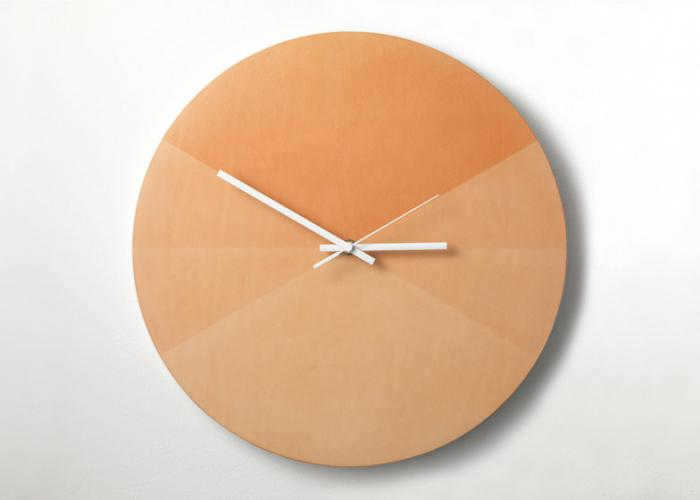
The Origin of a Universal Standard
In ancient times, the measurement of time was determined by the position of the Sun. Noon was marked when the Sun reached its highest point in the sky. This method was utilized by sundials, but proved to be imprecise. As society progressed, a need for a more universal and accurate system arose. With the discovery of new lands and the importance of navigational purposes, the concept of time zones was introduced. This led to the creation of the Greenwich Mean Time (GMT) system, which was named after the observatory in Greenwich, where the prime meridian was located.

By the way, before the implementation of this particular standard, different nations utilized their own reference points. Typically, the central meridians passed through local observatories, for instance, Paris in France and Pulkovo in Russia. However, the absence of a unified standard caused inconvenience. In 1884, the zero meridian was established at Greenwich and has been used ever since. It serves not only for clock synchronization but also for determining longitude.
The current standard is known as UTC or Coordinated Universal Time. Unlike GMT, it is synchronized with atomic clocks, and every 2-3 years, an “extra” second is added to the scale. This adjustment is made to align the time as closely as possible with astronomical time.
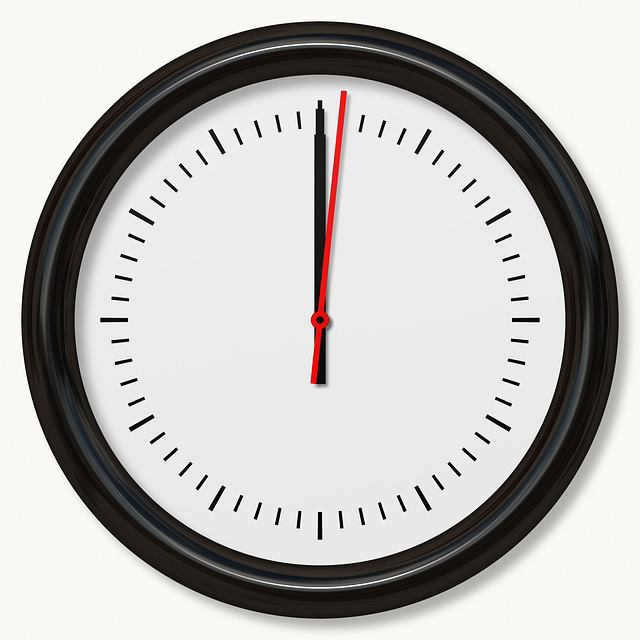
Designation of Time Zones
The time in different meridians is calculated based on Greenwich Mean Time (GMT). To simplify matters, it is represented as the difference from GMT, such as UTC+1, UTC-8, and so on. However, not all time zones are delimited by meridians, as this can sometimes be inconvenient. In fact, this has led to some interesting quirks in how time is counted in various countries. We will discuss these quirks in more detail later on.
Application
After understanding the concept of coordinated time, it is important to explore its usage in today’s society. Initially, the prime meridian continues to play a crucial role in navigation, both on sea and in the sky. Additionally, the requirement for a standardized time reference has been emphasized due to globalization. UTC is used to schedule conference calls involving individuals located in various parts of the world.

Incidentally, certain regions lack the concept of time zones. The Arctic and Antarctic regions, for instance, follow a convention of UTC+0. In these areas, researchers at polar stations have the freedom to determine their own timekeeping. This flexibility also applies to astronauts operating in Earth’s orbit.
Interesting trivia
The Coordinated Universal Time (UTC) system has a rich history, giving rise to some fascinating features.
- The abbreviation UTC does not officially stand for anything. When the standard was introduced in 1970, options such as TUC (Temps Universel Coordonné) and CUT (Coordinated Universal Time) were considered. Ultimately, the neutral UTC was chosen.
- Novosibirsk, a city founded on both banks of a river, lies directly along a meridian. For a long time, the city operated on two different time zones. This arrangement was not very inconvenient until the construction of the first bridge in 1955. Afterward, Novosibirsk switched to a single standard time.
- Logically, the largest time difference between two points on the planet should be 24 hours. However, in reality, there are 26 time zones. In the Pacific Ocean, there are two island nations in close proximity to each other: American Samoa and the Line Archipelago. The time difference between them is 25 hours. This is because the Line Islands, which were once part of Great Britain, set their time based on Australian time, resulting in UTC+14. Meanwhile, Samoa follows UTC-11, which is determined by its difference with mainland America.
- In certain regions of Australia, horizontal time zones occasionally come into play. This is because not all states observe daylight saving time.
- The difference with Greenwich is not always an even number of hours. Nepal follows UTC+5:45, some cities in Australia have a time difference of +8:45, and the Chatham Archipelago in New Zealand follows UTC+12:45.
Universal Time (UT) is a time standard that is derived from the Earth’s rotation. There exist multiple variations of Universal Time that differ by a few seconds. The two most commonly used versions are Coordinated Universal Time (UTC) and UT1 (refer to section § Versions). [1] All versions of UT, except for UTC, are based on the Earth’s rotation in relation to distant celestial objects such as stars and quasars. However, these versions have a scaling factor and other adjustments to align them more closely with solar time. UTC, on the other hand, is based on International Atomic Time, with the addition of leap seconds to ensure it stays within 0.9 seconds of UT1. [а]
Before the implementation of standard time, each municipality worldwide adjusted their official clocks, if they had any, based on the local position of the sun (referred to as solar time). This system worked well until the introduction of rail travel in Great Britain, which required constant clock readjustments as trains traveled quickly over long distances and passed through multiple towns in a single day. To address this issue, Greenwich Mean Time was established. This was the average solar time at the prime meridian in Greenwich, England. All clocks in Great Britain were set to this time, regardless of the local solar noon. Chronometers or telegraphy were utilized to synchronize these clocks. [3]

In astronomy, what is known as Universal Time is a system used to standardize time across the globe. As of 2016, the world is divided into different time zones, each with a specific number of hours added to Coordinated Universal Time (UTC) to determine local time.
Sir Sandford Fleming, a Scottish-Canadian, first proposed the concept of standard time at a meeting of the Canadian Institute in Toronto on February 8, 1879. His idea was to establish time zones that could be used locally, while still adhering to a single world time known as Cosmic Time. Fleming’s proposal divided the globe into twenty-four time zones, each spanning 15 degrees of longitude. Within each zone, all clocks would be set to the same time, but they would differ by one hour from clocks in adjacent zones. On October 22, 1884, at the conclusion of the International Meridian Conference, the Royal Observatory at Greenwich was designated as the recommended reference point for world time. This choice was made because, by that time, two-thirds of all nautical charts and maps already used Greenwich as their prime meridian. However, the conference did not adopt Fleming’s time zone system, as it was not within the scope of the conference’s purpose, which was to select the basis for world time and the prime meridian.
From 1848 to 1972, the majority of countries around the world implemented time zones that were based on the Greenwich meridian. [7]
In 1935, the International Astronomical Union suggested using the term World Time instead of Greenwich Mean Time, as it was considered to be a more accurate description. This was because GMT could refer to either an astronomical day starting at noon or a civil day starting at midnight. [8] In certain countries, the term GMT is still commonly used to refer to civilian timekeeping.
Observing celestial bodies crossing the meridian each day allows for the measurement of time, as it is based on the rotation of the Earth. Astronomers have discovered that the most accurate way to establish time is by observing stars as they cross the meridian, rather than relying on the position of the sun in the sky. At present, the determination of UT (Coordinated Universal Time) relative to International Atomic Time (TAI) is done through Very Long Baseline Interferometry (VLBI) observations of distant quasars. This method enables the determination of UT1 with an accuracy of 15 microseconds or better.

“Universal Dial Plate” from 1853 displays the comparative time of “every nation” prior to the implementation of Universal Time.
The International Earth Rotation and Reference Systems Service (IERS) oversees the Earth’s rotation and UT, while the International Astronomical Union contributes to establishing guidelines. However, the International Telecommunication Union (ITU) serves as the ultimate authority for broadcasting standards. [11]
Earth’s rotation is experiencing some irregularities and gradually slowing down due to tidal acceleration. Additionally, the duration of a second was determined by observing the Moon between 1750 and 1890. These factors contribute to the modern average solar day being slightly longer than the traditional 86400 SI seconds. As a result, UT (Universal Time) has an irregular pace, prompting astronomers to introduce Ephemeris Time, which has now been replaced by Terrestrial Time (TT). Since Universal Time is based on the Earth’s rotation, which differs from more accurate atomic frequency standards, a second adjustment (known as a “second jump”) is necessary to align with atomic time. The broadcast time is generally synchronized with solar time, so it may deviate slightly from international atomic time, but efforts are made to prevent significant discrepancies.
Barycentric dynamic time (TDB), which is a type of atomic time, is currently being utilized to create ephemerides for planets and other celestial objects in the solar system for two primary reasons. [12] Firstly, these ephemerides are aligned with optical and radar observations of planetary movement, and the TDB time scale is specifically designed to ensure that Newton’s Laws of Motion, as modified by the general theory of relativity, are upheld. Additionally, time scales based on the Earth’s rotation are inconsistent and thus not appropriate for accurately predicting the movement of celestial bodies in our solar system.
There exist multiple versions of universal time:
- UT0 Universal time is determined at the observatory by observing the daily movement of stars or extragalactic radio sources, as well as from distance observations of the Moon and man-made satellites. The observatory’s location is assumed to have fixed coordinates in a terrestrial reference frame (such as the International Terrestrial Reference Frame), but the position of the Earth’s axis of rotation changes across the Earth’s surface; this is referred to as polar motion. UT0 does not incorporate adjustments for poleward movement. The discrepancy between UT0 and UT1 is approximately several tens of milliseconds. The term UT0 is no longer in use. [13]
- UT1 is the fundamental form of universal time. It is calculated by determining the positions of distant quasars using long baseline interferometry, laser location of the Moon and artificial satellites, and determination of GPS satellite orbits. These measurements help us determine the Earth’s rotation angle relative to distant quasars, known as the International Celestial Reference Frame (ICRF), which is the same everywhere on Earth. These measurements also allow us to calculate the Earth Rotation Angle (ERA), which serves as a modern replacement for Greenwich Mean Stellar Time. UT1 is crucial for tracking the ratio of Earth’s rotation to other celestial bodies.
- UT1R is a modified form of UT1 that eliminates cyclic variations induced by tidal forces. It incorporates 62 smoothing intervals with durations ranging from 5.6 days to 18.6 years. [15]
- UT2 is a modified form of UT1 that eliminates cyclic seasonal fluctuations. It is primarily of historical significance and is seldom utilized in contemporary times. It is defined
- Coordinated Universal Time (UTC) is a precise time scale that closely approximates UT1, the international standard for civil time. UTC follows the SI second and is synchronized with TAI. It typically consists of 86,400 SI seconds per day, but occasional random intercalary seconds are added or subtracted to keep it within 0.9 seconds of UT1. These leap seconds are always positive (resulting in days with 86,401 seconds) as of 2016. When a level of accuracy greater than one second is not required, UTC can be used as a reliable approximation of UT1. The difference between UT1 and UTC is referred to as DUT1. [17]
Adoption of Greenwich Meridian Time Zones in Various Countries
Displayed in the table are the adoption dates of Greenwich Meridian Time Zones across different countries, which also include half-hourly time zones.
Aside from Nepal Standard Time (UTC + 05: 45), the Chatham Standard Time Zone (UTC + 12: 45) is utilized in the Chatham Island of New Zealand[19], and the Central West Time Zone (UTC + 8: 45) is unofficially used in Eucla, Western Australia and its surrounding regions. All other time zones are determined by an offset from UTC in increments of half an hour, and in many cases, in increments of an hour.





